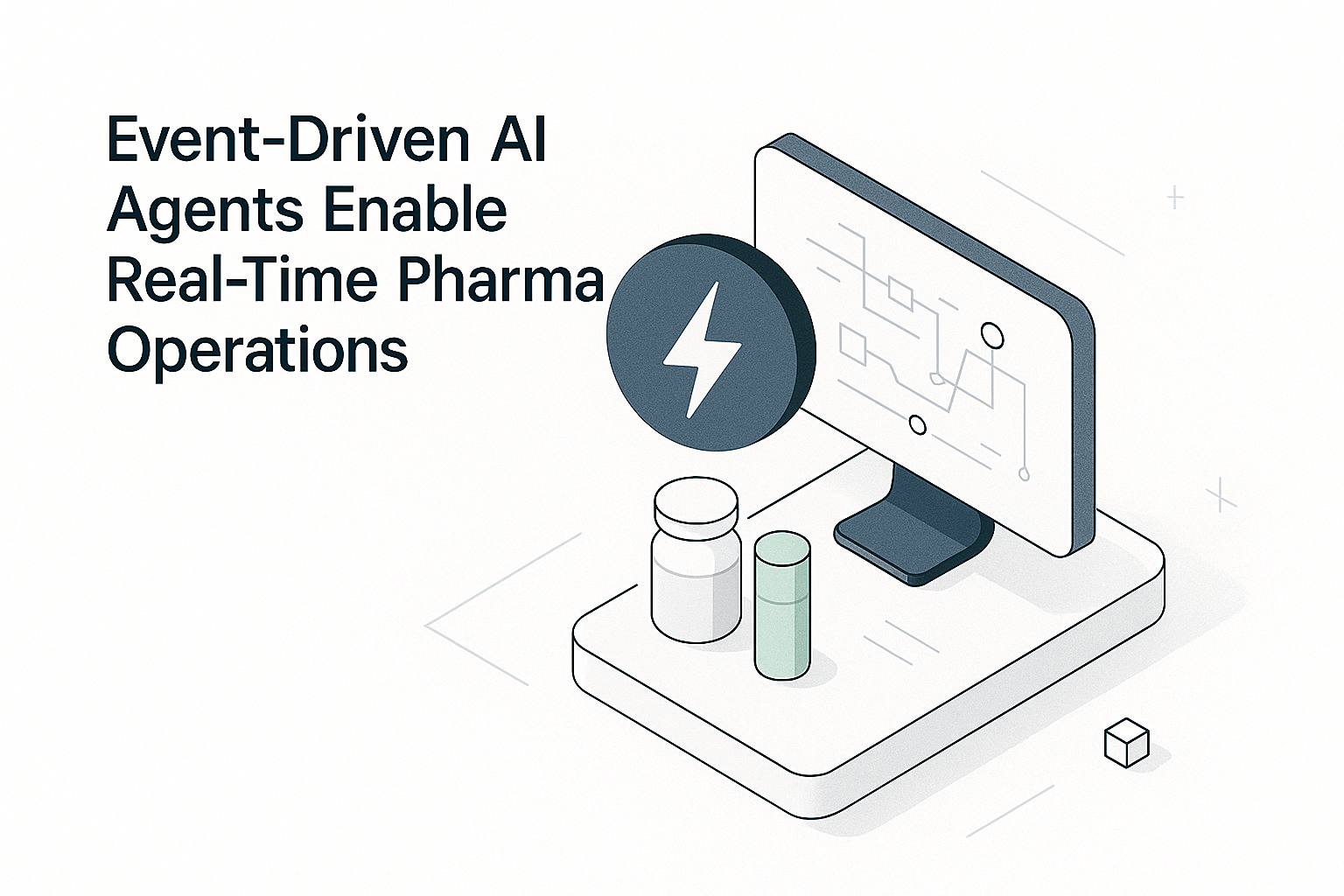How Event-Driven Architectures Power Real-Time AI Agents in Pharma
Estimated Reading Time: 6 minutes
- Transformative Impact: Event-driven architectures revolutionize pharmaceutical operations by enabling real-time responses to critical data.
- Integration Simplicity: They decouple legacy systems and modern AI, enhancing operational flexibility without disrupting existing infrastructures.
- Data Accuracy: EDA ensures synchronized decision-making, crucial for regulatory compliance and patient safety.
- Technological Backbone: Technologies like Apache Kafka and Flink are critical in processing vast volumes of real-time data effectively.
- Strategic Benefits: Real-time AI agents streamline decision-making processes, optimize manufacturing, and enhance patient care.
Table of Contents
- The Event-Driven Revolution: More Than Just Speed
- Why Real-Time AI Agents Need Event-Driven Foundations
- The Technology Stack: Apache Kafka and Flink in Action
- Real-World Applications: From Lab to Patient
- Strategic Advantages: Beyond Technology
- Implementation Strategies: Making the Transition
The Event-Driven Revolution: More Than Just Speed
At its core, an event-driven architecture is a software design paradigm where system components communicate by producing and consuming events. Think of it as a hyperactive nervous system for your pharmaceutical infrastructure—every significant change in state, whether it’s a new lab result, sensor reading, or prescription update, is recognized and acted upon in real time.
But here’s where it gets interesting for pharma: this isn’t just about speed. In an industry where a single contaminated batch can cost millions and regulatory compliance isn’t optional, EDA represents a fundamental shift from “find and fix” to “predict and prevent.”
Traditional pharmaceutical systems operate like a series of isolated islands, with data flowing in predictable batches and reports generated on scheduled intervals. Event-driven architectures, however, transform these islands into a connected ecosystem where information flows like electricity through a neural network. Every sensor reading from a manufacturing line, every vital sign from a clinical trial participant, every quality check from a laboratory becomes an event that can trigger immediate, intelligent responses.
Why Real-Time AI Agents Need Event-Driven Foundations
The marriage between EDA and AI agents in pharma isn’t accidental—it’s essential. Modern pharmaceutical operations generate an overwhelming volume of data streams that traditional systems simply can’t handle with the speed and precision required for optimal patient safety and operational efficiency.
Real-Time Responsiveness: The Millisecond Advantage
Consider the complexity of monitoring patient vitals for adverse effects during a clinical trial. In traditional systems, data might be collected, batched, and reviewed hours or even days later. With event-driven AI agents, every heartbeat, every blood pressure reading, every laboratory result becomes an event that AI processes instantly. The agent doesn’t wait for a daily report—it’s constantly vigilant, always ready to detect patterns that human observers might miss or notice too late.
This real-time capability extends beyond patient monitoring. In drug manufacturing, AI agents can respond to quality metrics in real-time, adjusting production parameters or halting processes before defective products are created. The difference between catching a problem in milliseconds versus hours can mean the difference between a minor adjustment and a major recall.
Decoupled Systems: The Integration Challenge Solved
One of the biggest headaches in pharmaceutical IT is integrating diverse systems—from legacy laboratory information management systems (LIMS) to modern IoT sensors on manufacturing equipment. Event-driven architectures solve this by decoupling data producers from data consumers.
Your decades-old chromatography system doesn’t need to understand how to talk directly to your cutting-edge AI model. Instead, both speak the universal language of events. The chromatography system produces events when analyses are complete, and the AI agent consumes these events to update its understanding of product quality. This approach enables pharmaceutical companies to modernize incrementally, adding AI capabilities without the massive disruption of replacing entire IT infrastructures.
Data Consistency: The Trust Factor
In pharmaceuticals, data accuracy isn’t just important—it’s literally a matter of life and death. EDA ensures that every consumer sees exactly the same events in the same order. When an AI agent makes a decision based on laboratory data, regulatory systems, quality assurance teams, and manufacturing systems all see the same information simultaneously. This synchronized decision-making capability is crucial for maintaining the audit trails and data integrity that regulatory bodies demand.
The Technology Stack: Apache Kafka and Flink in Action
The backbone of most event-driven pharmaceutical AI implementations relies on two powerhouse technologies that work in perfect harmony: Apache Kafka and Apache Flink.
Apache Kafka: The Event Highway
Apache Kafka functions as the central nervous system of event-driven pharmaceutical operations. It manages the real-time flow of events between countless producers—laboratory devices, IoT sensors, electronic health records, manufacturing equipment—and consumers like AI models, dashboards, and regulatory reporting systems.
What makes Kafka particularly valuable in pharma is its fault tolerance and reliability. When you’re monitoring a critical clinical trial or managing drug production, system failures aren’t just inconvenient—they’re potentially catastrophic. Kafka ensures that even if individual services fail, the event stream continues flowing, and AI agents maintain their vigilant watch over pharmaceutical operations.
Apache Flink: The Real-Time Brain
While Kafka handles the transport of events, Apache Flink processes them in real-time. Think of Flink as the analytical powerhouse that enables AI agents to make sense of thousands of concurrent event streams. It can process laboratory results as they arrive, correlate them with patient data, compare them against historical patterns, and trigger alerts or actions—all within milliseconds of the original event.
Together, Kafka and Flink create a platform where pharmaceutical AI agents can operate at the speed of data itself, processing information as it’s generated rather than waiting for batch processing windows.
Real-World Applications: From Lab to Patient
The practical applications of event-driven AI agents in pharma span the entire value chain, from drug discovery to patient care, creating unprecedented opportunities for innovation and safety improvements.
Clinical Trial Revolution
Modern clinical trials generate enormous volumes of data from multiple sources: wearable devices tracking patient activities, laboratory systems analyzing blood samples, electronic case report forms capturing physician observations. Traditional approaches struggle to synthesize this information quickly enough to identify safety signals or protocol deviations before they become serious problems.
Event-driven AI agents change this completely. They can process event streams from all these sources simultaneously, detecting subtle correlations that might indicate emerging safety concerns. For instance, an AI agent might notice that patients taking a particular dosage show slightly elevated liver enzymes combined with decreased activity levels—a pattern that might not be obvious when looking at each data source individually but could indicate a significant safety signal requiring immediate investigation.
Smart Manufacturing: Quality at the Speed of Production
Pharmaceutical manufacturing involves countless variables that can affect product quality: temperature fluctuations, humidity changes, raw material variations, equipment wear. Event-driven AI agents can monitor all these factors in real-time, learning the complex relationships between variables and product quality outcomes.
When sensors detect conditions that historically correlate with quality issues, AI agents can immediately adjust parameters or halt production. This proactive approach prevents defective products from being manufactured rather than catching them during final quality control—a shift that can save millions in waste and prevent potentially dangerous products from reaching patients.
Pharmacovigilance: Always-On Safety Monitoring
Traditional pharmacovigilance relies on periodic safety reviews and manual signal detection. Event-driven AI agents enable continuous, real-time surveillance across multiple data sources: adverse event reports, social media mentions, electronic health records, insurance claims data.
These agents can identify emerging safety signals within hours rather than months, enabling faster responses to potential risks. They can also prioritize signals based on severity and confidence levels, ensuring that human safety experts focus their attention on the most critical concerns.
Personalized Healthcare: Treatment at the Individual Level
Perhaps the most exciting application involves using event-driven AI agents to deliver personalized care. As patients generate data through wearable devices, medication adherence apps, and routine healthcare interactions, AI agents can process these events to continuously refine treatment recommendations.
An AI agent might notice that a patient’s medication adherence drops on weekends, correlate this with effectiveness measures, and suggest dosing schedule adjustments. Or it might detect early signs of treatment resistance and recommend proactive interventions before clinical symptoms become apparent.
Strategic Advantages: Beyond Technology
The benefits of implementing event-driven architectures for real-time AI agents extend far beyond technical capabilities, creating strategic advantages that can fundamentally reshape how pharmaceutical companies operate and compete.
Accelerated Decision Cycles
In an industry where regulatory timelines stretch innovation cycles to years or decades, the ability to make informed decisions in real-time represents a competitive breakthrough. Faster decision cycles enable pharmaceutical companies to respond to emerging opportunities or threats before competitors even recognize they exist.
Consider adaptive clinical trials, where AI agents can analyze interim results and recommend protocol modifications in real-time. Instead of waiting for scheduled interim analyses, these systems can continuously optimize trial parameters, potentially reducing overall trial duration while improving patient outcomes.
Operational Excellence Through Automation
Event-driven AI agents excel at handling routine but critical tasks that traditionally require human monitoring. This operational efficiency doesn’t eliminate human expertise—it elevates it by freeing professionals to focus on complex cases that require human judgment while ensuring that routine monitoring never lapses.
Manufacturing quality assurance, regulatory compliance monitoring, and safety signal detection can all operate continuously without human intervention, while escalating only the situations that genuinely require human expertise.
Regulatory Compliance as a Competitive Advantage
The detailed, real-time audit trail generated by event-driven systems creates unprecedented transparency for regulatory bodies. Rather than reconstructing what happened weeks or months after an event, pharmaceutical companies can provide regulators with complete, timestamped records of every decision and action taken by AI agents.
This level of documentation can accelerate regulatory reviews and demonstrate a level of quality control that sets companies apart from competitors still operating with traditional systems.
Implementation Strategies: Making the Transition
Successfully implementing event-driven architectures for real-time AI agents requires careful planning and a strategic approach that balances ambition with practical constraints.
Start Small, Think Big
The most successful implementations begin with pilot projects that demonstrate value while building organizational capability. Choose a specific use case with clear success metrics—perhaps monitoring a single manufacturing line or tracking safety signals for a particular drug. This approach allows teams to learn the technology and develop expertise before tackling more complex implementations.
Data Architecture Foundation
Before deploying AI agents, ensure your data architecture can support real-time event processing. This often requires upgrading network infrastructure, implementing proper data governance, and establishing security protocols for sensitive pharmaceutical data. Proper integration planning is crucial for connecting diverse systems without disrupting ongoing operations.
Change Management
Perhaps the biggest challenge isn’t technical—it’s cultural. Moving from batch-oriented, periodic review processes to real-time, AI-driven decision making requires significant changes in how teams work. Invest heavily in training and change management to ensure that people understand and trust the new systems.
Regulatory Alignment
Engage with regulatory bodies early in the implementation process. While event-driven AI agents can enhance compliance and safety, they also raise new questions about validation, audit trails, and decision accountability. Proactive engagement with regulators can help establish frameworks for approval and ongoing oversight.
The pharmaceutical industry stands at an inflection point where traditional, reactive approaches to data management and decision-making are giving way to intelligent, proactive systems powered by event-driven architectures. Companies that successfully implement real-time AI agents will gain substantial competitive advantages in safety monitoring, operational efficiency, and innovation speed.
As this technology matures and adoption accelerates, event-driven architectures are catalyzing the next wave of digital transformation in life sciences. The companies that master this transition won’t just be more efficient—they’ll be fundamentally different organizations, capable of operating at the speed of data itself while maintaining the safety and quality standards that patient care demands.
The future of pharmaceutical operations is real-time, intelligent, and event-driven. The question isn’t whether this transformation will happen, but whether your organization will lead it or follow it.
Ready to explore how adaptive AI can transform your pharmaceutical operations? Connect with our experts at VALIDIUM to discover how event-driven architectures can power your real-time AI initiatives.


